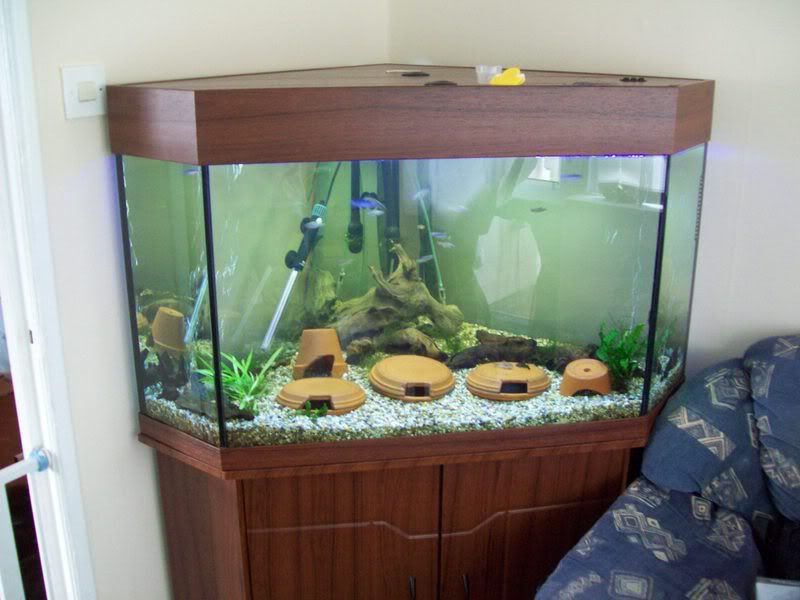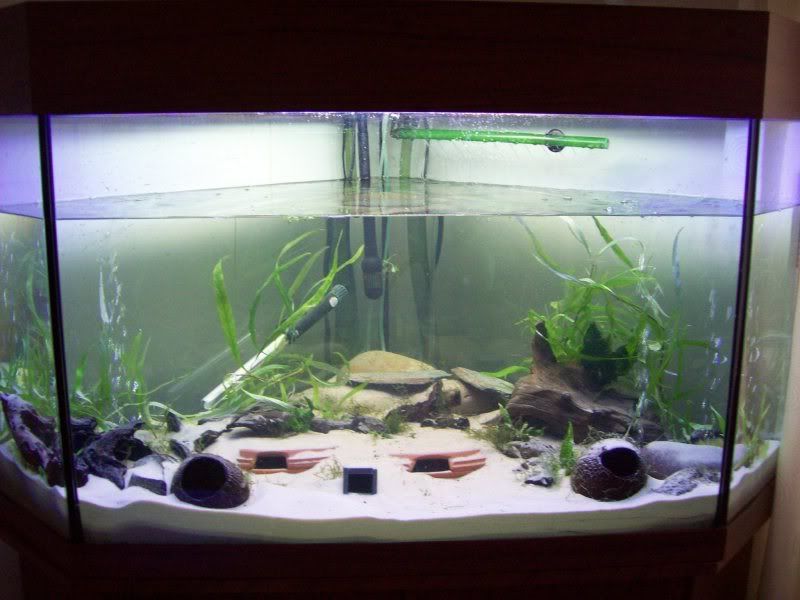Page 2 of 2
Re: breeding L182 brstlenose tips please blackwater tips
Posted: 04 Dec 2008, 22:49
by MatsP
I know, you don't have a car and such, but:
http://www.wickes.co.uk/Obsolete-Cold-w ... nvt/443154
or something along those lines (screwfix do cold water tanks in various shapes, delivered). I've got two standing on a tall stand (around 4.5ft/1.4m), so that I can just connect a hose to a tap on one side and let gravity feed the tanks. Or you can get a pump that will lift the water into your destination container.
[You can of course also buy an aquarium of the appropriate size to store the water].
Output of the RO system will increase when summer comes along and the water is a bit warmer, but it's not quick.
--
Mats
Re: breeding L182 brstlenose tips please blackwater tips
Posted: 17 Dec 2008, 20:19
by seanie112
update
today we have change the tank corner 252ltr tank from gravel to sand and added caves and bogwood and some plants
plus i taken nearly all the water part from abt 10% i am at the moment putting in ro water to full it up then i will be adding the fish bk in as they are at the moment in a holding tank 3ft then on friday will be putting the L182 bristlenose bk in just found a female traped found her dead dont know how ong she been there for
so now i have 3x male and 8x females going bk in tank i am hoping to put a trio in there own tank just after xmas
will add a photo of the tank was before the change and a photo after when i can in the next couple days
Re: breeding L182 brstlenose tips please blackwater tips
Posted: 17 Dec 2008, 20:52
by MatsP
Make sure that you acclimatise the fish for a good time if you make such a dramatic change in the water conditions - I personally would have moved the fish first, and then done regular water changes of say 20-30% per week, until you reach your target conductivity (TDS or conductivity meter comes in handy here).
--
Mats
Re: breeding L182 brstlenose tips please blackwater tips
Posted: 17 Dec 2008, 21:11
by seanie112
i have moved the fish to a holding tank 3ft one till the tank is done
can u del the other theard for me then please thx
Re: breeding L182 brstlenose tips please blackwater tips
Posted: 17 Dec 2008, 21:23
by MatsP
I'll leave the other thread as it is - just don't post any more there if you post in this thread. If you think you have something that is NOT relevant in this thread, but is REALLY relevant to the other thread, then post there - what I object to is posting the same (or essentially the same) information in two different threads that discuss roughly the same thing.
It's fine to move the fish from one tank to another as long as the water conditions (pH, conductivity [hardness, KH, salinity], temperature, etc) is (within reason) the same. What you never should do is move fish from hard water to really soft water or the other way around - they will get "pH shock" which is probably more correctly expressed as "osmotic shock", because apart from the pH value itself, the water conditions within a low pH tank is generally soft, and a high pH tank is generally hard. The fish will have mechanisms in the body to keep essential minerals in balance. If the fish ALL OF A SUDDEN go from an environment where there is more minerals in the water than they need in the body to an environment where the water is low in minerals, these mechanisms will have to work "the other way around" - not keeping stuff out, but keeping it in. That change-over isn't immediate, so slowly acclimatising the fish is essential.
One way to do that is to drip water from the new home tank into a large tub - I usually use an air-hose, using a knot on the hose to restrict the water flow. Make sure there is some circulation in the tub so that the oxygen level is kept high, as this will remove at least one of the potential stress factors. I'd say something like 12-36 hours is the required period for transitioning.
--
Mats
Re: breeding L182 brstlenose tips please blackwater tips
Posted: 18 Dec 2008, 11:37
by seanie112
last nites test
so far i have added 80 ltrs of ro water to the tank and the ph is still on 7.5 to 8.0
so at the moment ph has not droped i have half a tank left to full of ro water
thursday test ie 2day
just done another test after i have added 25ltrs of ro water and the ph is now between 6.0 and 6.5
i have another 80ltrs or so to be added to the tank
photo of wot it was like little old photo just had more plants in it

this photo is wot its like now half full of ro water 90% and 10% old water

Re: breeding L182 brstlenose tips please blackwater tips
Posted: 31 Jan 2009, 16:06
by seanie112
these are now sold they finaly breed and sold them with fry
now i am keeping longfins bristlenose and they are breeding as well
will do a thread soon abt them
Re: breeding L182 brstlenose tips please blackwater tips
Posted: 18 Nov 2009, 15:51
by anasteso1454
I just found this thread and want to ask, now that it has been about a year, how is your breeding project going? I have some thoughts about what was said on this thread.
it is correct that one German degree of hardness equals approx 17.90 ppm. Keep in mind that GH test kits mostly test calcium and magnesium compounds, while stuff like TDS meters measure the total conductivity (anion & cation) of all charged particles in the water. This will not detect organics, neutral particles, viral and bacterial particles, etc.
almost everything you put in your tank likely will raise GH. According to my test results, here are some rates of mineralization for a few things, per week, in pure (RO/DI) water (corrected for residual ionic particles from the unit):
substance mass water volume rate, per week
lace rock 10 g 100 ml ~10 ppm
petrified wood 10 g 100 ml ~4 ppm
laterite (pure, unmixed) 10 g 100 ml ~3 ppm
These are baseline estimates and will have to be extrapolated for larger masses and water volumes, and also accounted for other factors that will accelerate or decrease the rate of mineralization. In fact, even flake food will increase the total ppm in your aquarium. Take a very small pinch of crushed flake, drop it in a glass of pure water, test the tds and it would read somewhere around 10-12 instantly, and add another 10-12 over 24 hrs. Plant fertlizers will greatly increase the total tds in your aquarium though I am not sure if the reference books take this into account when suggesting waht the total GH range should be. To my knowledge low tds only becomes necessary for mature, breeding adults; for juveniles a higher tds is recommendable to promote health during the growth stage.
ccording to spectra pure the maker of a brand of RO DI, the water is unfit for human consumption in large quantities, every day, b/c it will actually wash out nutrients from your body by osmosis. Small quanitities, not every day, should have not significant effect (besides it really does make great coffee, tea, etc!). officially speaking, the FDA "does not classify DI resins (which leach into the water) as consumable food products."
sand as a substrate is good for a fish-only tank, only when a substrate heater is used so that circulation of water through the sand is kept constant. as was said above if it is not circulated it will become anaerobic and produce toxic H2SO2 but only if it is distrubed. Keep in mind that if the tank is planted and sand is used, a substrate heater is an excellent addition although it is not required. True the substrate would produce anaerobic conditions but in a planted tank this is not bad, it is only serving a different purpose. If you can promote great root development the plant roots themselves will prevent anaerobic conditions, so in a heavily panted tank it will virtually elimate the need to clean the gravel. Any anaerobic spots in a planted tank will not only produce H2SO2 but also nitrogen gas, a critical macronutrient for plant development. as always you dont want the anaerobic zones to get out of control or to stir it up and produce H2SO4 in your tank, so the answer to the question is "it is both good and bad."
from what I know, once the pH drops below 5.0 all nitrifying bacteria die and the nitogren cycle cannot take place. So it would seem that well before the pH dropped even farther, you would first experience an ammonia spike that would kill off all your fish unless you stay on top of water changes.
Re: breeding L182 brstlenose tips please blackwater tips
Posted: 28 Nov 2009, 23:47
by Barbie
Ammonia is converted to ammonium under a pH of 6.0, from my understanding, and also non toxic. The danger would be a water change or buffer addition that brought the pH up much at all. Very dangerous idea, either way.
Barbie
Re: breeding L182 brstlenose tips please blackwater tips
Posted: 29 Nov 2009, 05:52
by Jon
Ammonium is still quite toxic. In fact, more often than not, when speaking of "ammonia" in an aquarist context, it's usually a reference to ammonium as being a de facto result of ammonia protonation in water rather than ammonia itself, since in hobby-relevant ranges, ammonium predominates.
Re: breeding L182 brstlenose tips please blackwater tips
Posted: 29 Nov 2009, 20:36
by Barbie
What is ammonia converted to when you add ammo lock or amquel? I try to avoid having ammonia period, (adequate filtration and water changes and what not) so I'd love to hear how the chemical "fixes" work if my interpretation was incorrect ;).
Barbie
Re: breeding L182 brstlenose tips please blackwater tips
Posted: 29 Nov 2009, 22:12
by MatsP
It forms a tight bond with the Ammonia. More info here:
http://www.novalek.com/kordon/articles/ ... lworks.htm
[Amazing what you can find when using google!]
--
Mats
Re: breeding L182 brstlenose tips please blackwater tips
Posted: 30 Nov 2009, 00:02
by Jon
Chemical equilibrium are not static in this case (and pretty much all acid-base solutions), which means NH3<->NH4, and then you get binding.
Re: breeding L182 brstlenose tips please blackwater tips
Posted: 30 Nov 2009, 10:02
by MatsP
Jon wrote:Chemical equilibrium are not static in this case (and pretty much all acid-base solutions), which means NH3<->NH4, and then you get binding.
Yes, of course. Chemistry is never "exact", things swing back and forth. The meaning of "bind" here is rather that it "holds" the ammonia (or ammonium ions, I expect) better than water in itself.
--
Mats

